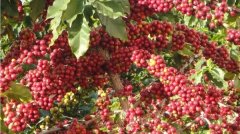Sharing the production process of coffee beans
It takes as long as 3-5 years for a coffee tree drama to steal and grow to a beautiful end. 6-10 years of coffee trees are the most likely to bear fruit, about 15-20 years, is a bumper harvest. Coffee trees are usually bred in nurseries and grow into saplings, and then moved to coffee farms a year later, completely following the way the Arabs planted and cultivated coffee trees at the time. In the first four or five years of the development of coffee trees, the roots will continue to take root, the trunks will grow upward, and the branches will grow into an umbrella, so that they can bear rich and unbeautiful fruit in the future.

Because if the coffee is exposed to direct sunlight and the leaf temperature rises, the stomata will be blocked and unable to receive carbon dioxide, and the coffee tree will curb its development. Some taller trees will be planted next to the coffee tree to avoid being exposed to the sun for a long time. Usually some tropical cash crops such as bananas, betel nuts and so on. Spraying bananas and other cash crop trees not only shade, but also through photosynthetic infiltration, the generation of carbohydrates for coffee trees to develop energy. Because sprayed bananas develop rapidly and can be used as by-product economic income, it can be said that coffee and sprayed bananas are good brothers of tropical cash crops.
Coffee trees can only be developed in tropical and subtropical regions, and coffee trees can develop in the middle of the "coffee belt" in terms of weather, soil, altitude and rainfall. Coffee trees flourish in the hot and humid canyons and forest rainforests of Africa; it still produces high-quality coffee beans in cold, foggy, windy Central America; and in the changeable, rainy and rainy Caribbean Sea, it still blossoms and blossoms. These identities are the secret that coffee beans have different flavors and a wide variety.
Important Notice :
前街咖啡 FrontStreet Coffee has moved to new addredd:
FrontStreet Coffee Address: 315,Donghua East Road,GuangZhou
Tel:020 38364473
- Prev

Coffee beans what are the male and female beans of all kinds of coffee?
Recently, the theory of public beans and mother beans is quite popular. A partner who has just returned from Bali, Indonesia, and the bar manager of a five-star hotel both talked about it with me. The former said that when she went to Bali, the locals recommended public beans to her and did a cup test on the spot. The taste of male beans is better than mother beans, while the latter extolled to me that all the beans supplied by their suppliers are public beans, not a single mother bean. Good end
- Next

Coffee knowledge-- about the growth process of Coffee trees
The coffee tree is an evergreen tree with small white flowers and green flowers that turn red when it is mature. A normal coffee tree can usually grow to 5 to 10 meters high, but for the convenience of harvesting, bean farmers often prune it to less than 2 meters. After flowering, there are many dark green ellipses, and the mature ones change from dark green to bright red.
Related
- Guji coffee producing area of Guji, Ethiopia: Humbela, Shakiso, Wulaga
- What is the most expensive variety of Qiloso in BOP multi-variety group?
- How to store the coffee beans bought home?
- Why are Yemeni coffee beans so rare now?
- Ethiopian Sidamo all Red Fruit Sun Sun Santa Vini Coffee beans
- SOE is mostly sour? What does it mean? Is it a single bean? what's the difference between it and Italian blending?
- Is Italian coffee beans suitable for making hand-brewed coffee?
- How to choose coffee beans when making cold coffee? What kind of coffee beans are suitable for making cold coffee?
- Just entered the pit to make coffee, what kind of coffee beans should be chosen?
- Can only Japan buy real Blue Mountain Coffee? What are authentic Jamaican Blue Mountain coffee beans?

